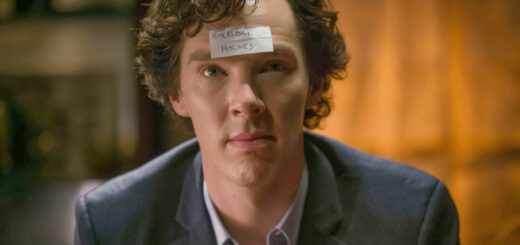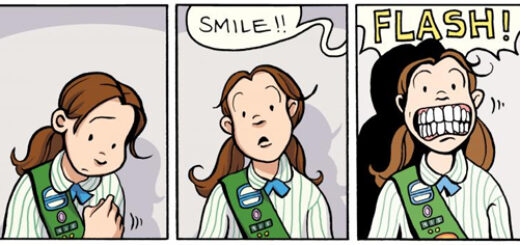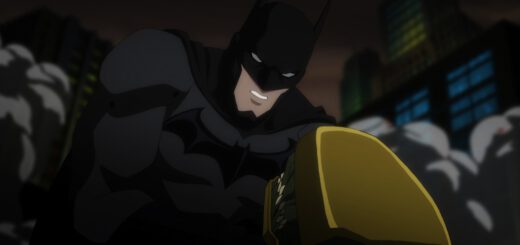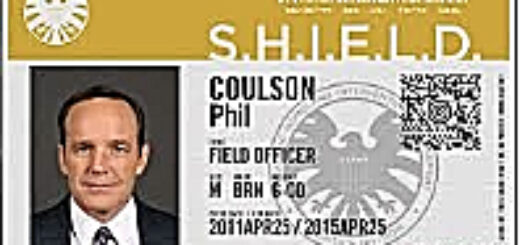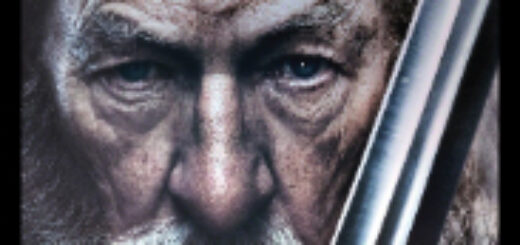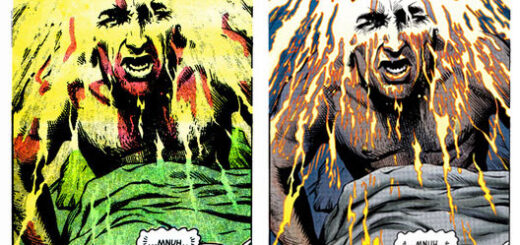Category: Reviews
John Ostrander: “Sherlock” Season Three: Is The Game Off?
Several years ago, when I first heard that the BBC was doing a version of the Arthur Conan Doyle’s Sherlock Holmes stories re-set in the modern day, I was skeptical. I’ve long loved the Holmes stories. I believe I finished reading the Canon for the first time by the age of ten. For me, part of the charm was the fog/smog filled Victorian streets of London, with the hansom cabs, the gaslights, et al. For me, the era and setting were as much characters in the stories as Holmes and Watson. I might have given the series a pass except that the co-creator and frequent writer for the series was going to be Steven Moffat.
I knew Moffat from some remarkable work he had done on Doctor Who. He has penned what I felt were some of the best episodes I’d ever watched on the series, full of surprises but also deep feeling, moments that truly touched me. So I gave his new series, co-created with writer/actor Mark Gatiss, a look and was generally delighted. The modern setting worked surprisingly well and, while not faithful to the letter of the stories, kept to the spirit of Conan Doyle’s canon. The series benefited as well from a very strong Holmes and Watson in the persons of Benedict Cumberbatch and Martin Freeman respectively.
Each season consists of just three ninety minute episodes and each has ended on something of a cliffhanger or at least we are left with questions to be answered. We’re introduced to their version of Holmes’s arch nemesis, James Moriarty, at the end of the first season as he puts Holmes and Watson into a death trap with no seeming escape. At the end of the second season, Moffat and Gatiss do their version of the last meeting of the two. In their version, it results with Moriarty blowing his own brains out and Holmes forced to jump to his apparent death. We know Holmes is not dead by the end of the episode but we don’t know how he managed it. That would have to wait for Season Three. In theory.
Spoiler Alert. Lots of spoilers below. (more…)
REVIEW: “Justice League: War”
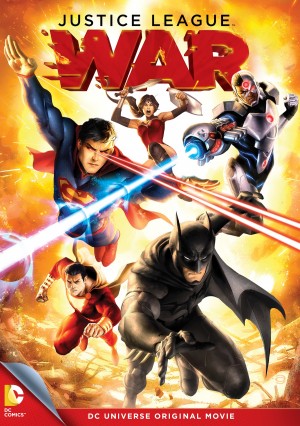 The Warner Animation series of direct-to-disc features has apparently said farewell to the past as this week’s release of [[[Justice League: War]]] and May’s [[[Son of Batman]]] are both from the New 52 era. A pity given how many cool stories remain unadapted. Readers who picked up Justice League #1 in August 2011 were treated to a brand new take on the tried and true characters from DC Comics, but it was clearly early in their collective careers. It was the first time many were meeting one another and dealing with the threat of Darkseid from Apokolips.
The Warner Animation series of direct-to-disc features has apparently said farewell to the past as this week’s release of [[[Justice League: War]]] and May’s [[[Son of Batman]]] are both from the New 52 era. A pity given how many cool stories remain unadapted. Readers who picked up Justice League #1 in August 2011 were treated to a brand new take on the tried and true characters from DC Comics, but it was clearly early in their collective careers. It was the first time many were meeting one another and dealing with the threat of Darkseid from Apokolips.
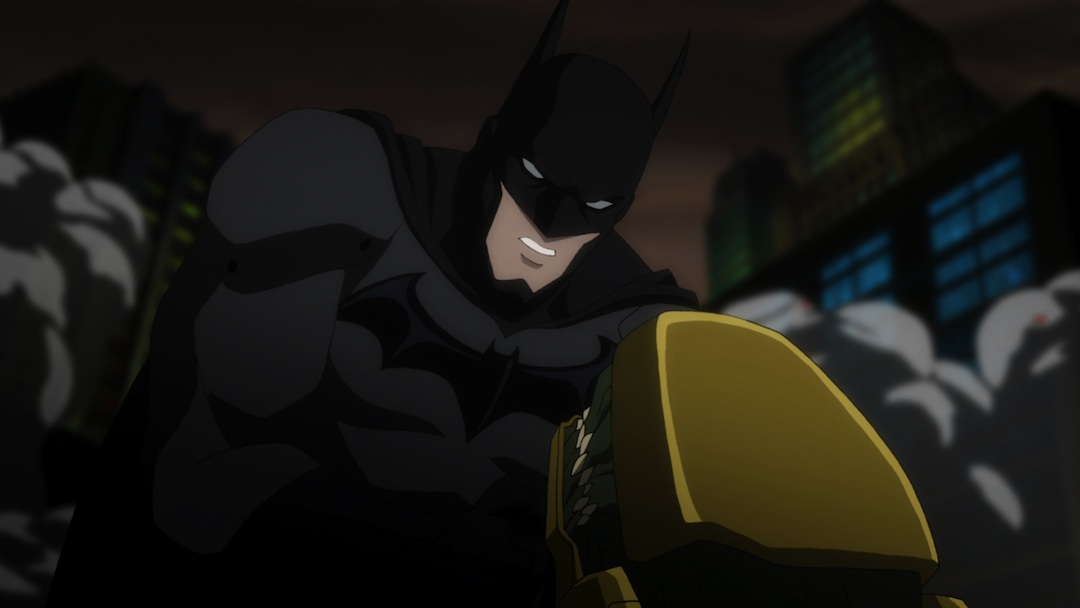 A fresh start but far from a clean one but discussions of that title and the entire New 52 belong elsewhere. Right now, we’re examining the latest feature from director Jay Oliva to see how well it stands up on its own. He’s working from a script by Heath Corson, making his DC animated debut after writing Scary Godmother: Halloween Spooktacular and six episode s of Aim High. He hews closely to Geoff Johns’ opening six-issue arc, keeping a lot of the action and dialogue but had to make accommodations when it was decided Aquaman would be jettisoned for Captain Marvel (okay, he’s now called Shazam, which sucks). As a result, the story is about seven heroes coming together for the common good but it’s really about Vic Stone’s transformation from promising teen athlete to cyborg warrior, using him as an audience identification figure.
A fresh start but far from a clean one but discussions of that title and the entire New 52 belong elsewhere. Right now, we’re examining the latest feature from director Jay Oliva to see how well it stands up on its own. He’s working from a script by Heath Corson, making his DC animated debut after writing Scary Godmother: Halloween Spooktacular and six episode s of Aim High. He hews closely to Geoff Johns’ opening six-issue arc, keeping a lot of the action and dialogue but had to make accommodations when it was decided Aquaman would be jettisoned for Captain Marvel (okay, he’s now called Shazam, which sucks). As a result, the story is about seven heroes coming together for the common good but it’s really about Vic Stone’s transformation from promising teen athlete to cyborg warrior, using him as an audience identification figure.
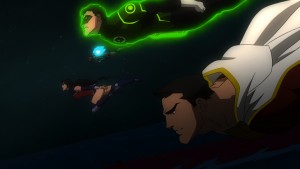 We open in Gotham City as Green Lantern arrives to deal with a parademon, believing it to be the urban legend Batman. When the real Dark Knight shows up, Green Lantern is surprised and then stunned to realize he’s just a guy in a suit. They don’t like one another but have to put that aside to deal with the growing number of parademons. Elsewhere, more parademons are threatening Washington DC, Central City, and Metropolis, leaving behind mysterious boxes that baffle scientists and heroes alike. Vic Stone comes to Central’s S.T.A.R. Labs to chew out his father for missing the big game – again – and is on hand when things go boom. Meantime, in Washington, Steve Trevor is bringing Wonder Woman to meet the President but things get delayed when the uglies arrive.
We open in Gotham City as Green Lantern arrives to deal with a parademon, believing it to be the urban legend Batman. When the real Dark Knight shows up, Green Lantern is surprised and then stunned to realize he’s just a guy in a suit. They don’t like one another but have to put that aside to deal with the growing number of parademons. Elsewhere, more parademons are threatening Washington DC, Central City, and Metropolis, leaving behind mysterious boxes that baffle scientists and heroes alike. Vic Stone comes to Central’s S.T.A.R. Labs to chew out his father for missing the big game – again – and is on hand when things go boom. Meantime, in Washington, Steve Trevor is bringing Wonder Woman to meet the President but things get delayed when the uglies arrive.
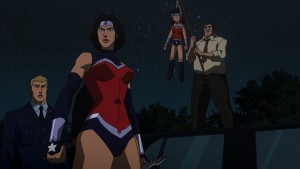 In time, we learn they are leaving Mother Boxes behind in an attempt to terraform Earth, paving the way for Darkseid to take control. Humanity would be repurposed into becoming parademons to grow his army. There’s lots of fighting, lots of bickering, quipping, and things blowing up before the heroes prevail.
In time, we learn they are leaving Mother Boxes behind in an attempt to terraform Earth, paving the way for Darkseid to take control. Humanity would be repurposed into becoming parademons to grow his army. There’s lots of fighting, lots of bickering, quipping, and things blowing up before the heroes prevail.
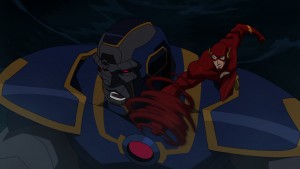 For us to believe these larger-than-life figures can exist, everything else around it has to make perfect sense. Instead, time and again, the story has gaps of logic or basic science that make you go, “aww, come on! “If Batman has been studying Superman before they encounter one another, he would either have a plan or come prepared because, you know, he’s Batman. Instead, we waste several minutes watching them duke it out. When Air Force One is breached by the parademons, apparently there’s no decompression in the cabin. And if we’re talking terraforming then why are the boxes being placed in these specific places and nowhere else on Earth? Or if they’re on all seven continents, we should address who is dealing with the parademons there and the effects on Earth’s environment. Nope, not touched on at all.
For us to believe these larger-than-life figures can exist, everything else around it has to make perfect sense. Instead, time and again, the story has gaps of logic or basic science that make you go, “aww, come on! “If Batman has been studying Superman before they encounter one another, he would either have a plan or come prepared because, you know, he’s Batman. Instead, we waste several minutes watching them duke it out. When Air Force One is breached by the parademons, apparently there’s no decompression in the cabin. And if we’re talking terraforming then why are the boxes being placed in these specific places and nowhere else on Earth? Or if they’re on all seven continents, we should address who is dealing with the parademons there and the effects on Earth’s environment. Nope, not touched on at all.
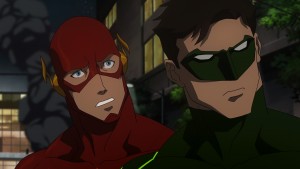 Instead, we get a Captain Marvel who is as gosh wow as Billy Batson is a brat, never once displaying the wisdom of Solomon. Oliva decided to play off the magical thunder and has it crackling around him and Marvel occasionally hurls bolts of lightning which is interesting but doesn’t serve the character well. Similarly, Wonder Woman comes across as a bumpkin, making proclamations about new discoveries with the earnestness of Jethro Bodine.
Instead, we get a Captain Marvel who is as gosh wow as Billy Batson is a brat, never once displaying the wisdom of Solomon. Oliva decided to play off the magical thunder and has it crackling around him and Marvel occasionally hurls bolts of lightning which is interesting but doesn’t serve the character well. Similarly, Wonder Woman comes across as a bumpkin, making proclamations about new discoveries with the earnestness of Jethro Bodine.
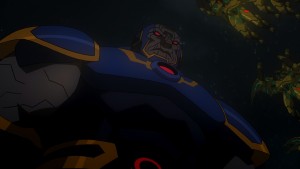 Overall, the origin story works pretty well if the action is prolonged at times in lieu of actual conversations between the characters. We get hints of a vast new playing field and it’s interesting to see that not all of them are convinced banding together more than once is a good idea – something that would be worthy of exploring in another film since the comic is long past that point.
Overall, the origin story works pretty well if the action is prolonged at times in lieu of actual conversations between the characters. We get hints of a vast new playing field and it’s interesting to see that not all of them are convinced banding together more than once is a good idea – something that would be worthy of exploring in another film since the comic is long past that point.
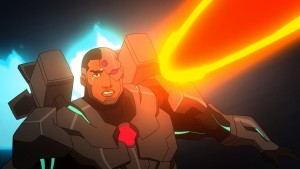 Interestingly, the character design this time around is from former DC artist Dusty Abell and he once more gives everyone pointy chins and adds extraneous details to GL’s uniform while mangling Flash’s chest bolt. WW’s outfit is a departure from the source material and sort of works. For a fresh take on these heroes, they look remarkably similar, unlike the radical re-envisioning Jim Lee brought to the printed page.
Interestingly, the character design this time around is from former DC artist Dusty Abell and he once more gives everyone pointy chins and adds extraneous details to GL’s uniform while mangling Flash’s chest bolt. WW’s outfit is a departure from the source material and sort of works. For a fresh take on these heroes, they look remarkably similar, unlike the radical re-envisioning Jim Lee brought to the printed page.
 The New 52 vocal cast works pretty well with Alan Tudyk making for a surprisingly good Superman while Jason O’Mara does equally well with Batman. Christopher Gorman’s Flash, Justin Kirk’s GL, and Shemar Moore’s Cyborg are just fine. Michelle Monaghan needed to tone down her Amazon Princess.
The New 52 vocal cast works pretty well with Alan Tudyk making for a surprisingly good Superman while Jason O’Mara does equally well with Batman. Christopher Gorman’s Flash, Justin Kirk’s GL, and Shemar Moore’s Cyborg are just fine. Michelle Monaghan needed to tone down her Amazon Princess.
The video release comes as a combo pack with a Blu-ray, DVD< and Ultraviolet copy. On the Blu-ray there are several featurettes starting with Deconstructing Justice League: War with Jay Oliva & Jim Lee as the two “meet” for the first time and dissect several sequences from the film, comparing print to animation and you learn some interesting things from it. There’s a surprisingly thorough look at Lee’s professional life in Creating Heroes: The Life and Art of Jim Lee, touching on his development as an artist and his time at Marvel before leaving to form WildStorm (nee Homage) and Image Comics. Finally, there’s Justice League: War Act D – From animatic to pencil test which has side by side by side comparisons of the same Act D scenes, which is interesting for those into art and animation.
Rounding out the disc is the usual preview of the next video, May’s Son of Batman, with O’Mara once more voicing the Caped Crusader and loosely adapting Grant Morrison’s storyline. Then there are four animated episodes which leave you scratching your head at the choices. These include Justice League Unlimited Season 3 “Destroyer”; Batman: The Brave and The Bold Season 2 “The Malicious Mr. Mind”; Young Justice Invasion: Destiny Calling Season 2 Part 1 “Happy New Year”; and Young Justice Invasion: Destiny Calling Season 2 Part 1 “Earthlings”.
REVIEW: The Dumbest Idea Ever!
The Dumbest Idea Ever!
By Jimmy Gownley
Scholastic Graphix, 236 pages, $11.99/$24.99
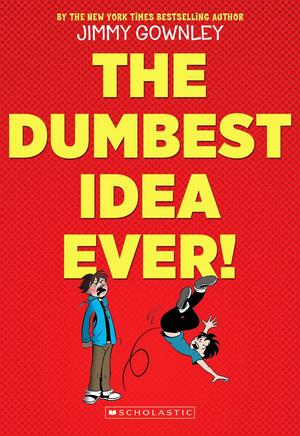 “Where do you get your ideas?”
“Where do you get your ideas?”
“Write what you know.”
One stereotypical question often leads to one stereotypical answer and in this case, the results have been magical. Jimmy Gownley is best known as the creator of Amanda Rules!, an utterly charming series of stories that are well worth your attention. Here, he reveals the secret origin of the comic in a delightful coming of age story that is highly recommended.
Gownley recounts how as a teen he was fascinated by comics when he wasn’t hanging with his friends and playing basketball for his private school in Girardville, PA. The nuns at the school found his interest in reading comics unacceptable so he prepared a compelling report on the value of graphic novels which earned him an A but failed to change his teacher’s mind. And it was only after then that he discovered comic book shops, opening his mind to material beyond super-heroes.
As he entered high school, he became obsessed with comics and art, which adversely affected his grades, but did lead to his meeting Ellen Toole, who was first a friend then a first girlfriend, a woman who never doubted his potential. Finally, he decided to try his hand at his own comic, inspired by Cerebus the Aardvark. He labored over the beginning of a space fantasy and turned the pages over to his best friend, who took three weeks to read it before delivering the verdict of “meh”. When his pal suggests Jimmy create a comic about “us”, he replies with “That’s the dumbest idea ever!”
But it’s also the beginning of Amelia and a career that has brightened countless readers’ lives and made Gownley a bonifide star creator. When the first issue is completed, his parents agreed to finance it being printed and so began an odyssey that brought fame, a swelled ego, and a lot of attention from teachers, friends, and the local media. His relationship with Ellen evolves and deepens along the way and he continues to play basketball, but in the end, it’s a rough road to fame and fortune. There’s a nice Author’s Note at the end which helps clear up some of the reality behind the graphic retelling of his early years.
Gownley’s eye-pleasing art and storytelling makes this a compelling read, one that should prove inspirational to budding creators across the land. While aimed at grades 4-7, it’s a universal enough story for all ages.
Dennis O’Neil: S.H.I.E.L.D and the Long Game
 So there it was, that kind of news item. We might once have seen something like it – a second cousin? – in the comics fanzines hobbyists published now. I find stuff like it virtually every day in Yahoo’s news section. This particular item speculated that Marvel’s Agents of S.H.I.E.L.D., which is, as you must know if you access this particular website, a television series broadcast on Tuesday night on ABC stations, is playing a long game. (Where do I collect my tortured syntax award?)
So there it was, that kind of news item. We might once have seen something like it – a second cousin? – in the comics fanzines hobbyists published now. I find stuff like it virtually every day in Yahoo’s news section. This particular item speculated that Marvel’s Agents of S.H.I.E.L.D., which is, as you must know if you access this particular website, a television series broadcast on Tuesday night on ABC stations, is playing a long game. (Where do I collect my tortured syntax award?)
It is maybe also common knowledge among you aficionados that the program is a disappointment in the ratings. Not doing too well, there on Tuesday night. We can speculate, as some already have, that viewers may feel that they have been prey to the old bait-and-switch gaff, promised one thing and presented with another. The TV honchos make a big deal of the show’s comic book origins, even including the word “Marvel” in the title, and prefacing every episode with the same montage of comic book images that precedes Marvel’s movies. So it’s reasonable to expect the kind of entertainment Marvel is most associated with, superhero stories. (If you’re a Marvel fan who cherishes the memory of Millie the Model, well… bless you!) But instead of superheroes, what do they give us? An action show. No flying, no awesome feats of strength, no grotesque superfoes, not even the odd cape or mask, Just, you know, fights and guns and car chases and stuff.
Not a bad action show, actually. Decent acting and dialogue, and stunts that seems to me to be a bit better than what’s usually found on the tube. And the plots are often flavored with science fiction, which could partially justify the superhero connection.
But, at the end of the hour… no superheroes. Wonder what’s on the Comedy Channel?
So they’re playing the long game? I interpret “long game” to mean that they’ll take their time, and ours, introducing characters and plot elements that will justify membership in the superhero club.
Comics got there first.
Twice, in my years behind editorial desks, the long game question arose, though we didn’t call it that. In one instance, a previous editor had promised the writer a five-year story. Awkward. I didn’t want to disappoint the writer, a good guy, and I may have been reluctant to make my predecessor a liar. But I doubted that any comic continuity of that era could be stretched so far. That’s the kind of decision editors are paid to make and sometimes the job can be a bitch.
We struck a deal. The long storyline could continue as long as sales remained above a certain number. Lagging circulation got the title cancelled and I was off the hook, and I hope the writer bears no ill memories of the incident.
The second long game was not being played on my turf, exactly, but because I was a big honkin’ group editor I had to notice it. If memory serves (and won’t that be the day?) the scripter planned to reveal certain crucial story elements several years into the run. The book didn’t last that long. Not even close.
The lesson we can take away from all this is that the long game won’t work unless you build an audience. Give ‘em solid reasons to keep coming back, episode after episode. Promising something, even implicitly, and then putting it on indefinite hold is not a good strategy.
THURSDAY AFTERNOON: Tweeks!
FRIDAY MORNING: Martha Thomases
SATURDAY MORNING: Marc Alan Fishman
John Ostrander: A Fair-to-Middling Earth
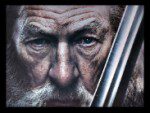 Different media have different demands, and adapting work done in one medium for another can be problematic. Comics, especially super-hero comics, used to be very difficult to make into films. We did not believe a man could fly; we believed he was lying belly down on a table with a fan blowing over him. However, CGI and other technology caught up with films and, today, some might say the superhero film is more faithful to the feel and spirit of the lead character than the comics are.
Different media have different demands, and adapting work done in one medium for another can be problematic. Comics, especially super-hero comics, used to be very difficult to make into films. We did not believe a man could fly; we believed he was lying belly down on a table with a fan blowing over him. However, CGI and other technology caught up with films and, today, some might say the superhero film is more faithful to the feel and spirit of the lead character than the comics are.
I think that’s the key, especially when adapting novels into films. Novels are too long to be strictly adapted into movies; Game of Thrones works fairly well, as does The Walking Dead, because they are TV series. The episodic nature allows for the kind of development that mirrors the length and structure of the source material.
It comes down to what do you keep in, what do you cut; what do you omit and what do you add; what plot elements are the most important, what are less important; what’s necessary to tell the story? What choices do you make? These are basic questions for any story but are even more vital when you’re adapting another person’s creation. How true must you be to the source material – to the letter or to the spirit? Who is the primary storyteller?
When it was first announced that The Lord of the Rings was going to be made into movies, I was hesitant, dubious, and worried. I love LotR and I just didn’t see how it could be done. However, director Peter Jackson made a believer out of me. His adaptation is not perfect, no, but the fact that it exists is damn near a miracle.
When The Hobbit was announced, initially I was very psyched. Originally, Peter Jackson was only going to produce, not direct, but due to delays he eventually wound up taking over the director’s reins again. J.R.R. Tolkien wrote The Hobbit initially as a children’s book and, while in the same setting of Middle-Earth as LotR, Tolkien only later amended the book to tie into the later work. Some characters appear in both works.
The Hobbit is a shorter book than LotR so I was only mildly concerned when it was announced it would be made into two films. It’s when Jackson announced it would become three films that I started to become apprehensive once again. Still, Jackson had earned my trust with LotR. I adopted a wait and see attitude.
Well, I’ve seen the first two parts of Jackson’s The Hobbit and I am somewhat less than thrilled. They’re not bad films per se but it’s been made very much into a prequel for Jackson’s LotR and not to the source material’s benefit.
Warning: spoilers of both the movies and the books follow.
The basic story is the same: the titular Hobbit, Bilbo Baggins, is dragooned into a motley crew of dwarves, led by Thorin Oakenshield, to reclaim their kingdom. Coming along is the wizard Gandalf the Gray. Woven into the story is how Bilbo won/stole the One Ring from Gollum. This, combined with an appendix Tolkien wrote, is the story of how the Great Enemy, Sauron, regrouped at Dol Guldur as the Necromancer until he was driven out by the White Council, including Gandalf (who disappears from The Hobbit’s storyline for a while to do this).
Adding this to the film makes sense and fleshing out that part of the story is fine. I also don’t have a problem with adding Legolas to the story or a new character, Tauriel, or even her possible romance with one of the dwarves. What bothers me is padding and bloating in the storyline. There’s a protracted running, jumping, yelling, fighting scene in the underground kingdom of the Goblins that could have been right out of the Mines of Moria sequence in LotR. It goes on way too long. Richard Armitage, as dwarf leader Thorin, is simply too good looking and something of a stand-in for Aragon in LotR. There’s a battle between the dwarves and the dragon, Smaug, within the mountain kingdom that simply never happened in the book and, again, goes on way too long.
For me, this is now less J.R.R. Tolkien’s The Hobbit and more Peter Jackson’s The Hobbit. It’s less about picking the elements to best tell the original story than what Jackson feels like doing. Some things he gets absolutely right, such as the aforementioned scene between Bilbo and Gollum. In that he keeps very close to the scene as written by Tolkien and it works wonderfully. A later scene, between Bilbo and Smaug, does not stick as closely to Tolkien and it suffers for it.
I will undoubtedly go to the third film when it comes out and I will have all three in DVD or Blu-Ray format as they become available, including the inevitable Director’s Cut versions which may be even more bloated. I understand this is Jackson’s vision of The Hobbit but it’s a lot darker than the book was. I’m very glad these films exist at all; I just would have liked it if they had been a little more Tolkien and a little less Jackson.
MONDAY: Mindy Newell
TUESDAY MORNING: Jen Krueger
TUESDAY AFTERNOON: Michael Davis
The Tweeks Review 2013
This week the Tweeks look back at the rest of 2013, giving us a twin tween take on what worked and what crashed and burned.
REVISED COLUMN SCHEDULE FOR THIS WEEK:
THURSDAY 5:00 EST USA: Mike Gold
FRIDAY: Dennis O’Neil, Martha Thomases, Michael Davis
REVIEW: Miracleman #1
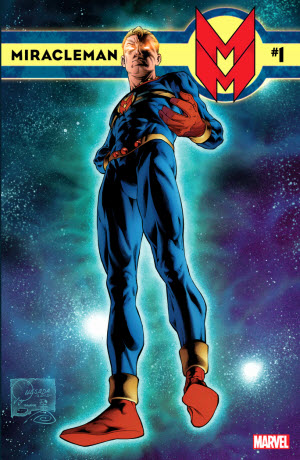
Miracleman #1 cover by Joe Quesada
I won’t lie to you… I never thought this day was coming.
I never thought Marvel Comics would be able to untangle the legal Gordian knot that was the history of the character originally known as Marvelman when they announced they’d secured the rights from creator Mick Anglo nearly five years ago. With all the people involved, all the hands through which the rights had passed, actually and allegedly, it seemed insurmountable. But Marvel took its time, with the patience of a father untangling the box of Christmas lights, and now here we are, a couple weeks after Christmas, but given a wonderful and shiny present.


